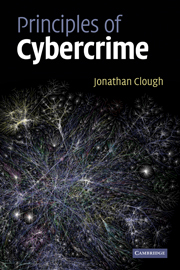Book contents
- Frontmatter
- Contents
- Preface
- Acknowledgements
- List of abbreviations
- Table of cases
- Table of legislation
- PART I Introduction
- 1 Cybercrime
- PART II Computer as target
- PART III Fraud and related offences
- PART IV Content-related offences
- PART V Offences against the person
- PART VI Jurisdiction
- Bibliography
- Index
1 - Cybercrime
Published online by Cambridge University Press: 05 June 2012
- Frontmatter
- Contents
- Preface
- Acknowledgements
- List of abbreviations
- Table of cases
- Table of legislation
- PART I Introduction
- 1 Cybercrime
- PART II Computer as target
- PART III Fraud and related offences
- PART IV Content-related offences
- PART V Offences against the person
- PART VI Jurisdiction
- Bibliography
- Index
Summary
The evolution of cybercrime
It is known of all men that the radical change in transportation of persons and goods effected by the introduction of the automobile, the speed with which it moves, and the ease with which evil-minded persons can avoid capture, have greatly encouraged and increased crimes.
What could be said of the automobile in the 1920s is equally apposite of digital technology today. It is trite, but nonetheless true, to say that we live in a digital age. The proliferation of digital technology, and the convergence of computing and communication devices, has transformed the way in which we socialise and do business. While overwhelmingly positive, there has also been a dark side to these developments. Proving the maxim that crime follows opportunity, virtually every advance has been accompanied by a corresponding niche to be exploited for criminal purposes.
The magic of digital cameras and sharing photos on the Internet is exploited by child pornographers. The convenience of electronic banking and online sales provides fertile ground for fraud. Electronic communication such as email and SMS may be used to stalk and harass. The ease with which digital media may be shared has led to an explosion in copyright infringement. Our increasing dependence on computers and digital networks makes the technology itself a tempting target; either for the gaining of information or as a means of causing disruption and damage.
- Type
- Chapter
- Information
- Principles of Cybercrime , pp. 3 - 24Publisher: Cambridge University PressPrint publication year: 2010



